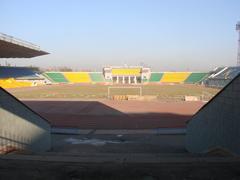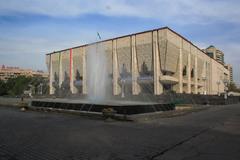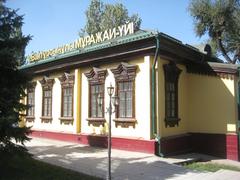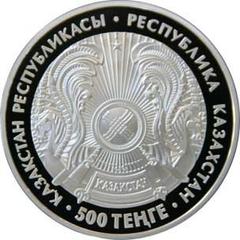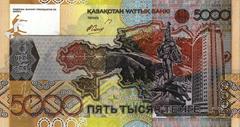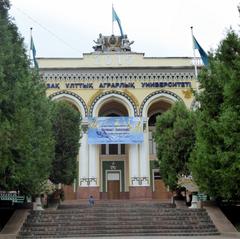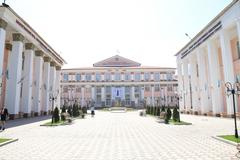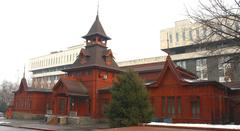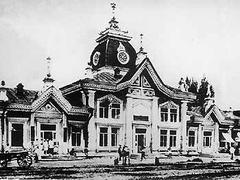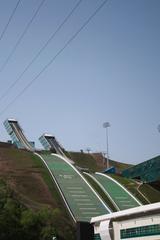Almaty Botanical Garden: Visiting Hours, Tickets, and Comprehensive Travel Guide
Date: 15/06/2025
Introduction
The Almaty Botanical Garden, situated in the heart of Almaty, Kazakhstan, is more than just a scenic urban retreat—it’s a living testament to the country’s botanical diversity, scientific legacy, and cultural richness. Established in 1932 under the USSR Academy of Sciences, this 104-hectare oasis seamlessly blends native and international flora, offering a sanctuary for over 7,000 plant species, including globally significant specimens like Malus sieversii and Allium pskemense. The garden is not only a paradise for plant enthusiasts but also serves as a vital center for research, conservation, and public education, managed by the Institute of Botany and Phytointroduction.
Visitors are greeted by a thoughtfully designed landscape featuring arboretums, Japanese-style gardens, tropical greenhouses, and recently modernized amenities such as wheelchair-friendly paths and tactile guides for the visually impaired. The garden also hosts educational programs, guided tours, and vibrant cultural events like the Nauryz Meyrami festival and the innovative Arkalan Petroglyph Nature Park, which celebrates Turkic heritage. Its proximity to Almaty’s major historical sites—such as Panfilov Park, Zenkov Cathedral, and the Central State Museum of Kazakhstan—makes it an essential stop on any city itinerary.
This guide provides a detailed overview of the Almaty Botanical Garden, including up-to-date visiting hours, ticket pricing, accessibility information, travel tips, and a look at the garden’s unique features and nearby attractions. For the most current information, consult the official websites and mobile resources provided by the garden. (Visiting Almaty Botanical Garden: Hours, Tickets, History, and Attractions, Almaty Botanical Garden: Visiting Hours, Tickets, and Exploring a Historic Botanical Treasure, Almaty Botanical Garden Visiting Hours, Tickets, and Guide to Almaty Historical Sites)
Table of Contents
- Introduction
- History and Development
- Visiting Information
- Facilities and Accessibility
- Garden Highlights
- Educational Programs & Events
- Travel Tips
- Nearby Attractions
- Frequently Asked Questions (FAQ)
- Conclusion and Planning Resources
History and Development
Founding and Early Years (1932–1946)
The Almaty Botanical Garden was inaugurated on March 14, 1932, reflecting the Soviet Union’s push for scientific advancement and environmental stewardship. Initially, it integrated both botanical and zoological sectors, later focusing on the study, acclimatization, and conservation of Kazakhstan’s diverse flora. In 1946, the garden was recognized as the Republican Botanical Garden under the Kazakh SSR Academy of Sciences, cementing its scientific and national importance.
Expansion and Conservation
During the Soviet era, the garden expanded its living collections and research facilities, playing a leading role in cataloging native plant species, introducing economically important varieties, and developing specialized arboreta and greenhouses. This scientific legacy established the garden as a vital resource for botanical research in Central Asia.
Challenges and Protection
Following Kazakhstan’s independence in 1991, the garden faced significant funding challenges and threats from urban development. Advocacy from local communities and scientists led to the garden’s designation as a “Specially Protected Natural Territory of Republican Significance” in 2006, ensuring its preservation for future generations.
Modernization and Revitalization (2018–2020)
A transformative $15 million renovation, spearheaded by the Bulat Utemuratov Foundation, modernized the garden’s infrastructure between 2018 and 2020. Enhancements included:
- Restoration of ponds and creation of new habitats
- Planting over 174,000 new specimens
- Construction of modern entrance pavilions with electronic ticketing
- Implementation of wheelchair-accessible paths and tactile guides
- Introduction of a mobile app featuring interactive maps and detailed plant information
In 2024, the Arkalan Petroglyph Nature Park was unveiled, celebrating Kazakh history through petroglyph art installations.
(Bulat Utemuratov Foundation reconstruction details, Arkalan Petroglyph Nature Park news)
Visiting Information
Opening Hours
- Spring–Autumn (April–October): 9:00 AM – 7:00 PM, daily
- Winter (November–March): 10:00 AM – 5:00 PM, daily
- Closed: January 1 and select national holidays
Ticket Prices
- Adults: 500 KZT
- Students & Seniors: 250–300 KZT (depending on the season and discount eligibility)
- Children under 7: Free
- Group Discounts: Available upon request
- Tickets: Purchase at the entrance or online via the official website. Electronic ticketing is supported.
Location & Transportation
- Address: The garden is located between Timiryazev, Zharokov, and Al-Farabi Avenue.
- Public Transport: Several bus routes stop near the main entrance.
- Taxi/Rideshare: Readily accessible options throughout Almaty.
- Parking: Limited parking available for private vehicles.
Facilities and Accessibility
- Wheelchair Access: Paved, wheelchair-friendly paths and ramps throughout the garden.
- Tactile Guides: For visually impaired visitors.
- Restrooms: Multiple accessible restrooms across the grounds.
- Café and Souvenir Shop: On-site for refreshments and gifts.
- Wi-Fi: Available in central areas.
- Seating & Picnic Areas: Benches, shaded pavilions, and picnic spots for relaxation.
- Pets: Allowed on leashes in designated areas.
- Staff Assistance: Available for those needing extra support.
Garden Highlights
Layout and Zones
- Arboretum: Diverse trees and shrubs organized by geographic origin.
- Japanese Garden: Tranquil water features, stone lanterns, and bridges against a mountain backdrop.
- Greenhouses: Tropical and subtropical plants, succulents, and rare species.
- Thematic Beds: Tulips, roses, irises, medicinal herbs.
- Naturalistic Meadows and Woodlands: Showcasing steppe and forest vegetation.
- Arkalan Petroglyph Nature Park: Outdoor installations of Turkic petroglyphs and cultural art.
Plant and Wildlife Diversity
- Over 7,000 plant species, including rare and endangered flora
- Key species: Wild apples (Malus sieversii), Tian Shan spruce, Allium pskemense
- More than 100 bird species, small mammals (squirrels, hedgehogs), and pollinators
- Wetland and meadow habitats supporting urban biodiversity
Scientific and Conservation Role
- Home to the Institute of Botany and Phytointroduction’s research
- Living laboratory for taxonomy, conservation biology, and urban greening studies
- Protected as a “Specially Protected Natural Area of National Importance” since 2006
Educational Programs & Events
- Guided Tours: Daily at 11:00 AM and 3:00 PM in Kazakh, Russian, and English; advanced booking recommended.
- Workshops: Themed events for children and adults, including plant care, scientific talks, and conservation education.
- School and University Programs: Hands-on learning in plant biology and ecology.
- Cultural Festivals: Nauryz Meyrami (Spring Equinox), art exhibitions, and seasonal community events.
Travel Tips
- Best Time to Visit: Spring (April–June) for cherry blossoms and vibrant blooms; autumn (September–October) for colorful foliage and mild weather.
- Photography: Popular spots include ponds, the Japanese Garden, and the Arkalan Petroglyph Nature Park.
- Visitor Conduct: Stay on marked paths, do not pick plants, and respect wildlife.
- Plan for Crowds: Visit early mornings or late afternoons for a quieter experience.
- App & Resources: Download the garden’s mobile app for interactive maps and plant information.
Nearby Attractions
- Panfilov Park: Historic city park with monuments and walking trails.
- Zenkov Cathedral: Iconic, all-wooden Orthodox cathedral in Panfilov Park.
- Central State Museum of Kazakhstan: Rich displays on the nation’s history and culture.
- Medeu Skating Rink & Shymbulak Ski Resort: Short drive from the city center for mountain recreation.
(Kazakhstan historical sites, Almaty tourist attractions)
Frequently Asked Questions (FAQ)
Q: What are the Almaty Botanical Garden’s opening hours?
A: 9:00 AM – 7:00 PM (April–October), 10:00 AM – 5:00 PM (November–March).
Q: How much are tickets?
A: Adults 500 KZT, students/seniors 250–300 KZT, children under 7 free.
Q: Is the garden wheelchair accessible?
A: Yes, with paved paths, ramps, and accessible facilities.
Q: Are guided tours available?
A: Yes, daily in multiple languages; advance booking recommended.
Q: Can I bring my pet?
A: Pets on leashes are allowed in designated zones.
Q: Is photography allowed?
A: Yes, photography is encouraged for personal use, except in restricted research areas.
Q: Are there volunteer opportunities?
A: Yes, contact the garden for information on conservation and educational volunteer programs.
Conclusion and Planning Resources
The Almaty Botanical Garden is an essential destination for anyone seeking a blend of nature, scientific discovery, and cultural enrichment in Kazakhstan’s largest city. With its modernized infrastructure, diverse living collections, and engaging community programs, the garden offers a memorable experience year-round. Enhance your visit by exploring the interactive app, joining a guided tour, or participating in seasonal events.
For the latest information on hours, tickets, events, and travel updates, consult the resources below and follow the garden’s official social media channels.
External Links
- Almaty Botanical Garden official page
- Bulat Utemuratov Foundation reconstruction details
- Arkalan Petroglyph Nature Park news
- Official Almaty Botanical Garden Website
- Visitor Information and Tickets
- Almaty Botanical Garden Visiting Hours, Tickets, and Guide to Almaty Historical Sites
Further Reading
- Visiting Almaty Botanical Garden: Hours, Tickets, History, and Attractions
- Almaty Botanical Garden: Visiting Hours, Tickets, and Exploring a Historic Botanical Treasure
- Almaty Botanical Garden Visiting Hours, Tickets, and Guide to Almaty Historical Sites
- Bulat Utemuratov Foundation reconstruction details
- Arkalan Petroglyph Nature Park news
Experience the Almaty Botanical Garden—a vibrant intersection of science, nature, and culture, and a highlight of any Almaty itinerary.

